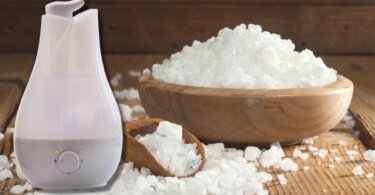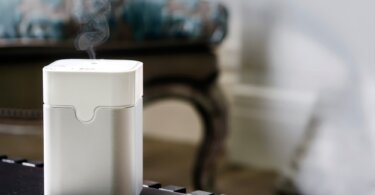Winter months can be painful for those with sensitive skin. The cold and dry climate can cause itchy skin and dry noses. Fortunately, a humidifier can increase the room’s relative humidity – but sometimes it seems like it takes forever for the air to get better even with your humidifier set at high!
So how long does a humidifier normally take to work? I cannot give a straightforward answer to this question because that depends on various parameters like the room size, capacity of the appliance, and humidifier placement. But most humidifiers will begin to work within a few minutes, and you can feel their effect anywhere between three to twenty-four hours.

How Does A Humidifier Make Your Dry Air Better?
A humidifier increases the humidity in a room by adding water droplets in the form of mist to the air. However, the effectiveness of this process depends on the appliance capacity and the total size of the room.
How Long Does A Humidifier Take To Work?
A humidifier will not produce mist instantly. Cool mist humidifiers, like ultrasonic and evaporative humidifiers, will work immediately. But warm mist humidifiers will take a minimum of five minutes to start functioning because the water (or other liquids) needs some time to warm up and start boiling.
Although the humidifier starts working within a few minutes, you will feel its effect only after a few hours. The humidifier adds water droplets into the air, but this process needs time to spread the water across the room.
Moreover, humidifiers differ from one another based on their capacity. Some are bigger and more powerful, while others may take a longer time to enhance humidity in the same room. So, it’s difficult to say how much exact time a humidifier will take to increase the humidity in a room.
What Are The Factors That Affects The Effectiveness Of Humidifiers?
The time taken for a humidifier to raise relative humidity depends on various factors. I’m listing some of them below.
1. Humidifier Type
Whole House Humidifiers
If you want to increase the relative humidity in the entire house in a very short time, invest in a whole-house humidifier. Please note that this device may be quite expensive compared to smaller ones.
However, if you are searching for a single-room humidifier, you can buy either a warm or cool mist humidifier, which I’ll explain below.
Warm Mist Humidifiers
Warm mist humidifiers are common in most offices and houses. These appliances create mist by boiling water. It takes a few minutes for them to start working once you switch them on.
Moreover, some warm mist humidifiers can also be a bit noisy. So check the reviews and then buy accordingly.
Ultrasonic Humidifiers
Cool mist humidifiers are mainly of two types, ultrasonic and evaporative humidifiers. Both work immediately after turning them on. Ultrasonic ones release fine mist through sound vibrations produced by striking two ceramic plates against each other.
Evaporative Humidifiers
These work on the simple principle of evaporation. If you dry your wet clothes in a room by blowing a fan over them, the water leaves the clothes but spreads inside the room. The same principle is used in evaporative heaters.
They have a reservoir that holds cold water and a vacuum filter that continually absorbs it. A fan blows over the vacuum filter, causing it to evaporate and increasing humidity in the room.
If you use a cool mist humidifier, then the relative humidity is increased within less time than a warm mist humidifier.
2. Output Rate
For most portable humidifiers, the output rate is somewhere between half a gallon to about nine gallons a day. This is the amount of water they can convert into mist and release in the room.
To get fast results, you should look to buy humidifiers that are on the higher end of the spectrum. Typically the output rating of a humidifier is available on the packaging, or else you can check it at the manufacturer’s website.
3. Room Size
Room size can significantly affect the efficiency of the humidifier. Portable humidifiers are usually meant only for single rooms, but if you are looking at a bigger area, it would be better to opt for a whole-house humidifier.
The water droplets added into the air per square inch will be proportionately lower as the room size increases.
4. Environment
The air usually has higher relative humidity in the morning than in the afternoon. Hence, a humidifier will usually work faster in the morning.
5. Structure Of The Room
If you keep a humidifier in a room with many doors and windows, dry air may seep in through cracks. Thus, the humidifier will take longer to increase the room’s relative humidity.
Related article: Does A Heater Reduce Humidity?
6. Furniture
If you are switching humidifiers in a room with a lot of furniture, the humidifier will take longer to work. Furniture absorbs mist and reduces the humidifier’s capability to make the air less dry.
7. Placement of The Humidifier
You should place the humidifier in the middle of the room, so that mist droplets get added to the air evenly. If you place it in one corner of the room, it will take longer to increase humidity in the opposite corner.
How Can You Make a Humidifier Work Efficiently?
Here are some tips for selecting the right humidifier that will work best for your room.
- Try to choose a humidifier according to the area of the room or house. Typical, a 1.500 sq. ft. home would need a humidifier of at least 7 gallons.
- Always keep the humidifier in the middle of the room so that it will work faster and evenly increases the relative humidity in the room.
- Keep the doors and windows closed when the humidifier is on.
Frequently Asked Questions
1. Does a humidifier humidify the whole room?
It depends on the type of humidifier you choose for the room. If you prefer cool mist humidifiers, they have the capacity to spread mist to a bigger area. But warm mist humidifiers cover limited areas. For very large rooms or complete houses, you might need to use a whole-house humidifier instead.
2. Is it ok to sleep next to a humidifier?
No, it’s not good to sleep next to a humidifier. You should leave at least 3 feet between yourself and the humidifier.
This is a safety measure to avoid exposing your body to a lot of moisture, which can cause respiratory infections. Additionally, keeping three feet distance from the humidifier will allow the appliance to spread mist evenly throughout the room.
3. Should a humidifier run all night?
Yes, you can leave the humidifier on all night. It can increase your sleep quality. There is no major harm in doing this unless you end up over-humidifying the house.
4. Can you over-humidify a room?
Yes, but over-humidifying a room is not good. If you over-humidify a room, you will experience condensation on the walls and ceiling. This can promote the growth of bacteria, algae, and other microorganisms. The furniture placed in the room might also get damaged.
Also check my article about Humidifiers For Singers: Vocal Chords Benefits.
Wrap Up
Humidifiers play an essential role in wintertime and in places where there is particularly dry air. But you should always buy one that is right for your room size. If you buy a unit that is too small, it will end up taking a long time to make the air less dry.





Leave a Comment